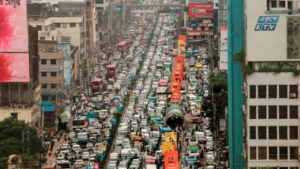
Imagine gliding across serene waters, a cool breeze brushing your face, while the city of Dhaka buzzes with chaos around you. No honking horns, no bumper-to-bumper gridlock—just a peaceful journey through the city’s hidden waterways. In a city known for its traffic nightmares, this might sound like a daydream. But what if it could be a reality?
Dhaka’s streets are bursting at the seams, with traffic crawling at an average speed barely above walking pace. The economic toll is staggering: billions in losses, millions of hours wasted. And for those who live here, the everyday frustrations of missed appointments, lost productivity, and stressful commutes are all too familiar. But what if, beneath all that congestion, a solution has been flowing unnoticed?
Rediscovering Dhaka’s Blue Arteries
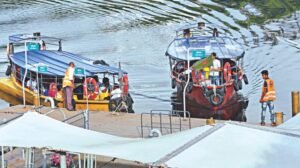
The city’s waterways—often neglected, often forgotten—might just hold the answer. To use often neglected waterways, the Hatirjheel waterbus, introduced in 2016, has already proven the concept. The Hatirjheel Lake flowing through the Begunbari and Gulshan areas of the Dhaka North City Corporation is the real ‘Narai’ River. The river flows from Begunbari to Demra and merges with the Balu River on the east side. With time, its name, nature, and identity had been forgotten. Bangladesh Army and the Special Works Organization renovated the middle part of the ‘Narai River’ (Hatirjheel Lake) and its environment. Prior to this restoration, there was a slum along the river. After rehabilitation, the approximately 302-acre area became one of the most beautiful sights and traffic-relieving centers. Apart from lake restoration, the project included the construction of an 8.80 km service road and an 8.80 km highway. A circular bus service was opened in the area in the year 2015. The Hatirjheel waterbus service was inaugurated on December 16, 2016. It presently connects FDC, Police Plaza, Gulshan, and Rampura.
The same ‘Narai’ River narrows to a stream on the east side, which flowed from Banasree via Meradia, Trimohoni and Demra. Its name now changed to Rampura Lake, meet Balu River at Demra. There is huge potential for the future expansion of Hatirjheel waterbus to the eastern part of the ‘Narai River’. Some informal boats now serve inhabitants along this route. Ideal School, Meradia, Trimohoni, and Demra points can be used as landing station for this probable new route.
Picture this: boats gliding through Hatirjheel Lake, carrying commuters faster than they could ever hope to travel by road. The journey is scenic, comfortable, and for many, a welcome break from the urban gridlock. No wonder passenger satisfaction has been so high. The most common reason passengers prefer the Hatirjheel waterbus is saving time, while comfort comes second (Nasrin and Happy, 2024). It also helps them avoid traffic and the inconveniences of overcrowded roads. So the passengers can have a comfortable and hassle-free journey. In addition, it can provide recreational benefits. For this reason after its opening from 2017 to 2022 number of passengers increased every year (except 2020-2021 because of the COVID-19 pandemic).
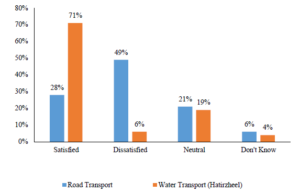
Perception of passengers for road transport and waterbus service (Nasrin & Happy, 2024)
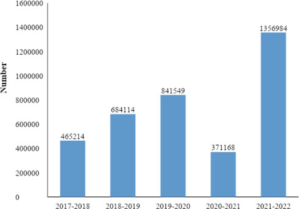
Source: (Nasrin and Happy, 2024)
Number of Passengers According to Fiscal Year
Inspired by this success, the possibility of expanding this waterbus service to new routes—from Banasree to Demra, connecting more communities through Dhaka’s network of natural waterways has been explored by Nasrin and Happy (2024). The benefits are clear: fewer cars on the road, quicker commutes, and an opportunity to enjoy the beauty of the city’s blue spaces instead of inhaling exhaust fumes.
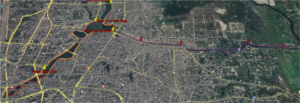
*Proposed Route: Pink line
*Proposed Water way station: Red place marker (Ideal school, Meradia Ghat, Trimohoni, and Demra)
*Existing Waterway (Hatirzheel) Route: Red Line
*Existing Waterway Station: Yellow place marker
Study Area Hatirjheel to Demra (Created with Google Earth Pro) (Nasrin and Happy, 2024)
Challenges: Not Without Stormy Waters
Of course, there are challenges. The existing waterbus service, though beloved, faces some bumps—queues during peak hours, a lack of proper waiting areas, and a shortage of basic facilities like toilets. And then there’s the state of the waterways themselves: pollution, illegal encroachments, and general neglect. But these challenges aren’t insurmountable. In fact, they represent opportunities—opportunities to restore and revive the city’s rivers, turning them into something more than just neglected backyards.
Imagine the transformation: riverbanks turned into vibrant green spaces, bustling landing stations where neighbors gather, and clean waters that reflect the city skyline. Beyond just a commute, these waterways could become part of the city’s identity—a space for recreation, relaxation, and reconnection.
A Vision for the Future: North to Purbachal, South to Tarabo
The potential doesn’t end with Hatirjheel. Picture waterbuses sailing not just through the heart of Dhaka but connecting its edges—north to Purbachal, south to Tarabo. The prospect proves with the vast number of passengers already using this route by informal boats (morning peak hour passengers- Banasree 620, Meradiya 370, Trimohoni 245, and Demra 230) (Nasrin and Happy, 2024). Imagine a city where you can hop on a waterbus and get to your destination twice as fast as by road, all while enjoying a scenic ride. Extending the waterbus network could create a seamless connection across Dhaka, making the waterways as vital as the roads and bridges that now bear the brunt of the city’s movement.
And it’s not just about commuting. It’s about giving the people of Dhaka an alternative. A choice that’s quieter, greener, and a whole lot less stressful. A choice to spend less time stuck in traffic and more time with loved ones. A choice to see the city from a new perspective—one that’s open, expansive, and full of possibilities.
Turning the Dream into Reality
To make this dream a reality, the government and community must come together to restore, expand, and innovate. There are plans for new landing stations, cleaning up encroached areas, and even adding amenities like waiting areas and digital ticketing systems. This isn’t just about waterbuses—it’s about urban transformation. It’s about reimagining what transportation in a developing city can be.
By embracing the potential of water transport, Dhaka can turn its waterways from a forgotten relic into a dynamic part of the urban experience. Imagine a future where waterbuses are as common as rickshaws, where getting to work is an experience you look forward to, not dread. A future where Dhaka’s rivers are once again its lifeblood, not just for transport but for the community and culture they nurture.
The Time Is Now
Dhaka has an opportunity to shift gears—or rather, shift tides. As we rethink urban transport, let’s look at what’s been flowing right under our noses. Let’s embrace the power of water to move people, connect communities, and transform lives. The waterways are waiting—let’s set sail.
Written By- Sharmin Nasrin, PhD
If you want to read the whole paper:
https://link.springer.com/chapter/10.1007/978-3-031-52303-8_17#citeas



Leave A Comment